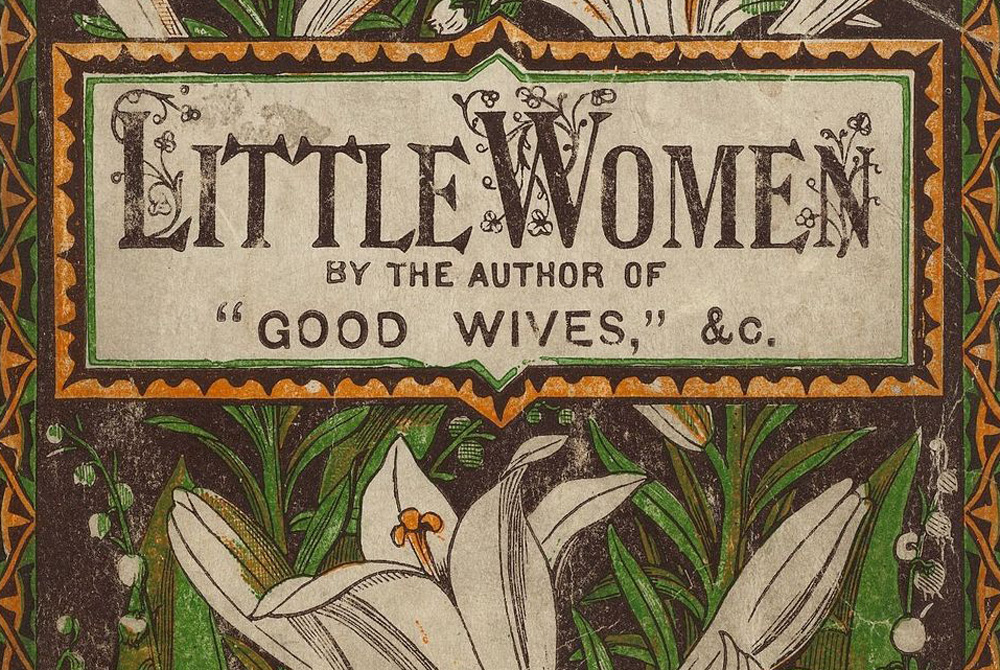
Title page from an 1878 English edition of "Little Women" by Louisa May Alcott (AC85.Aℓ194L.1869 pt.2aa, Houghton Library, Harvard University)
About a month ago, I was having lunch with some of my coworkers when we started talking about the new "Little Women" movie. Although several of us expressed excitement about it, one of my coworkers shared her reservations: “Do we really need another 'Little Women' movie? It’s been done so many times!”
I am sure there are others who have this same question about the latest version of "Little Women," which was written and directed by Greta Gerwig (whose previous film "Lady Bird" featured some of the most nuanced portrayals of men and women religious that I have seen in recent years, as well as some extremely cathartic nostalgia for people — like myself — who were in high school in the early 2000s). It was, and is, a good question, but as I told my coworker, I firmly believe that there are some stories whose themes are so timeless, so human, that each generation feels called to do its own adaptation.
In the weeks before the movie came out, I was eager to see how this adaptation would shed new light on these themes. When I finally saw the film on New Year’s Day with the rest of my community, I was expecting to like it; I was not, however, expecting to be so moved by it. After all, there is nothing about the movie that is surprising to those of us who have read the book and seen the other film adaptations. Beth still dies. Amy still marries Laurie. Meg still gets married.
Even so, I found myself walking out of the theater with a red face, swollen eyes (I dare you to see this movie and not cry) and a soaring heart. In the weeks since then, I can’t stop reflecting on how the same story that I loved as a child could still impact me so much as an adult. And I think part of the answer to this question lies in what this adaptation of Little Women has revealed to me about my experience in religious life.
When I was a girl, I loved the playfulness of Little Women. As one of five children, I could relate to the push and pull of the relationships between the March children, how they could have fun together but also annoy and hurt each other (Amy burning Jo’s book is an iconic scene that still makes me cringe because it is so devastating). Greta Gerwig’s adaptation is faithful to all these aspects of this beloved classic, and she does a masterful job at adapting it.
What I think she does most effectively, though, is to accentuate what makes Little Women such a classic story—it’s a love story. Some people might be surprised by the way that Gerwig’s adaptation makes it ambiguous whether or not Jo gets married. This ambiguity partially highlights the pressures that Louisa May Alcott may have faced to ensure that all her characters marry by the end of the book. However, what this ambiguity also highlights is the fact that in reality, it doesn’t matter if or to whom Jo marries because that is not the love story of the movie. The true love story is between Jo and her sisters.
In our culture, we tend to focus on and idealize romantic love stories. If there are two lead characters in a movie or television series, they are usually expected to get together by the end and live happily ever after (and if they don’t, we often wish they would!). This idealization or exclusive focus on romantic love in popular media reflects a larger tendency in our culture to see sexual or romantic love as the only kind of love worth talking about or living for.
I certainly see this attitude reflected in assumptions people make about the celibate life. Since joining the Marianist Sisters six years ago, I have had plenty of conversations with all sorts of people who assume that because priests and religious do not have that one person with whom they share sexual and romantic love, we must be unfulfilled, dissatisfied, and lead lives utterly lacking in love. This assumption suggests that romantic love must be the only true love, the only love that matters. However, I think one of the great gifts of celibacy is that, when lived well, it witnesses to the fact that there are so many and different kinds of love in our lives, and there are so many ways to love other people.
"Little Women" offers a powerful insight into the significance of all types of love, but it especially conveys the truth and complexity of love among sisters. This may be what I find to be most moving and to best express Alcott’s genius in "Little Women": its depiction of sisterhood and all the shades of what that means. The messiness that comes from living together. The fun we can have together. The ways we sometimes hurt each other. The heartbreak of loss that we heal from together. This is the kind of love and mess that all women religious in community are called to embrace. Seeing this love depicted on screen was a powerful reflection of my own life’s experience, and I think that is what moved me so deeply.
That’s what good art is supposed to do, isn’t it?
[Sr. Gabrielle Bibeau professed first vows in the Daughters of Mary Immaculate (Marianist Sisters) in May 2017. She is currently a Research and Program Assistant at the North American Center for Marianist Studies in Dayton, Ohio.]
Advertisement





